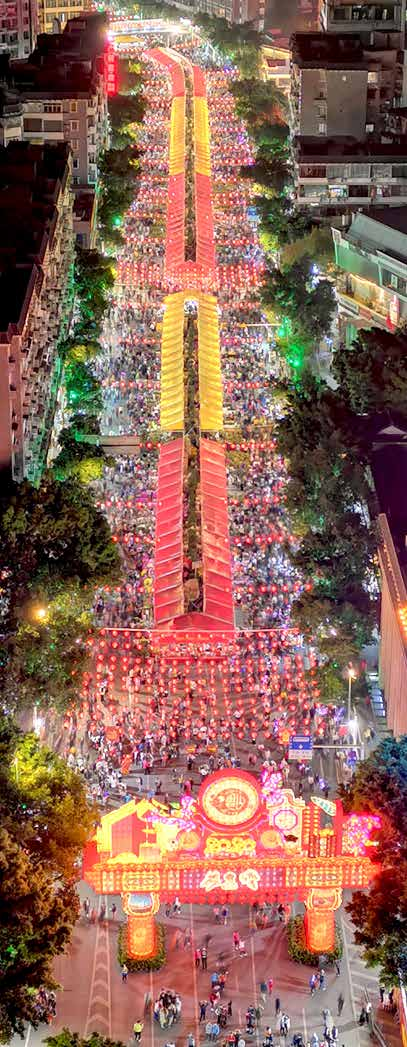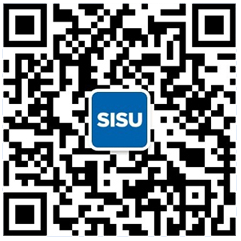广州,四季如春、繁花满城。在这座城市,鲜花不仅仅是一种装饰,更是一种生活方式和文化象征。每逢春节,广州的“八大花市”热闹非凡,欣欣向荣的节日氛围四处洋溢。粤语中很多花名与中国的一些吉祥祝福语发音相似,这又让鲜花承载了更多美好的寓意。这座“花城”不仅招致众多文人墨客吟咏称赞,也吸引无数游客慕名前来,人们奔赴花城,只为来一场与鲜花的浪漫约会。
让我们一起阅读《孔子学院》中的文章《“花城”广州》,感受一代代广州人对美好生活的热爱与期许。
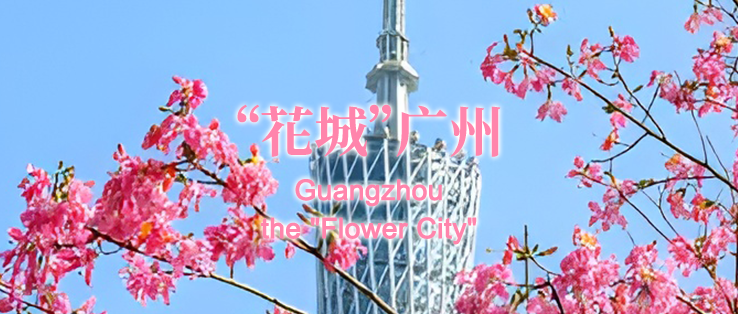
供稿:广东外语外贸大学
Guangdong University of Foreign Studies
作者:李敏俐 Li Minli
翻译:汤敏 Tang Min
广州,位于中国华南地区,是一座充满人文关怀的城市,享有“花城”的美誉。
Guangzhou, a city famous for its strong humanistic care in southern China, is the renowned “Flower City”.
广州的雅称“花城”最早出现于清代广州府管辖的花县,即现在的广州市花都区。20世纪60年代,文学大师秦牧在散文作品《花城》中这样描述:“看着繁花锦绣,赏着姹紫嫣红,想起这种一日之间广州忽然变成了一座‘花城’,几乎全城的人都出来深夜赏花的情景,真是感到美妙。”这部作品描绘的人山人海、繁花锦绣的广州花市盛况令人心驰神往,广州“花城”的称号也因此响亮起来。
As early as the Qing Dynasty, there was the Hua County (hua means lower) under the juristiction of the then Guangzhou authorities. It has evolved into today's Huadu District of Guangzhou. In the 1960s, Qin Mu, a literary master, depicted the charm of the city in his essay Flower City. He wrote, As I gaze at the colorful, vibrant blossoms, it occurs to me that the city of Guangzhou has become a 'flower city' overnight, and people flock to the streets to savor the floral beauty even late at night. What a wonderful experience. His portrayal vividly describes the robust atmosphere in the city's flower market with the bustling crowds and the blooming lowers, solidifying Guangzhou’s reputation as the Flower City.
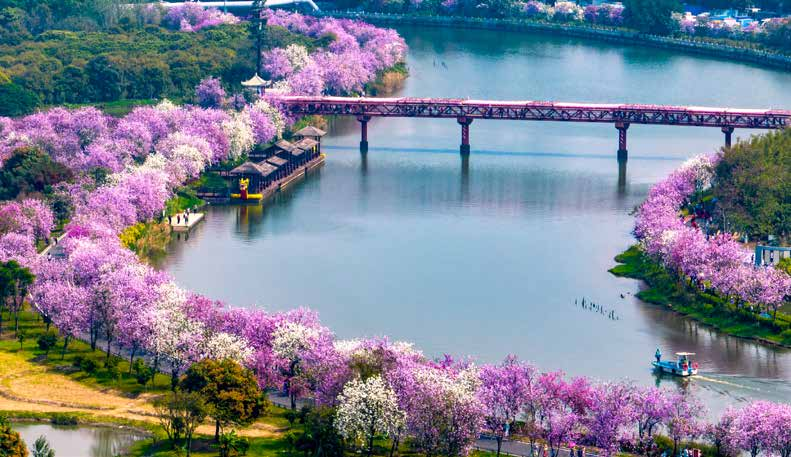
广州之所以叫“花城”,是因为在这里四季都会有鲜花相伴。初春三月,整座城市都被姹紫嫣红包围。漫步于广州的街头小巷,无处不浪漫,无处不飞花,你可以随时邂逅一场与粉色有关的浪漫约会,满足对春天的所有幻想与期待。盛夏六月的荔湾湖,微风拂过,泛起阵阵涟漪,荷叶随风摇曳,阳光轻洒在含苞欲放的荷花上。金秋十月,搭上一趟有轨电车,马路旁的美丽异木棉夹道相迎,仿佛置身于漫天粉色烟火之中。隆冬一月,郁金香恣意绽放,吸引着慕名而来的游客。人们沐浴在柔和的阳光之下,仿佛走进了莫奈的花园。在追求美的新时代里,“鲜花经济”成为拉动广州经济增长的一支重要力量。广州拥有种花面积10万多亩、鲜花品种2 000多个,全中国超过60%的观赏型室内植物也都发自广州。因此,广州被称为 “世界花卉之都”毫不为过。
Guangzhou earned its title as the Flower City because flowers flourish here all year round. In early spring, the city is adorned with hues of pink, red, and purple as lowers burst into full bloom. A casual walk down the streets and alleys is like a romantic date with spring, with every element you’ve anticipated for the season right before your eyes. In summer, the Liwan Lake ripples under the caress of the gentle breeze, with lotus leaves swaying and lotus flower buds bathed in the soft sunlight. When you take a tram ride in autumn along the streets adorned with blooming Kapok trees and look up, it feels as if you are enjoying a spectacular pink fireworks display. In winter, tulips bloom freely with vigor, attracting visitors from distant places.
With the flowers bathed in the gentle sunlight, you might just wonder if you have stepped into Monet's garden. In this new era, marked by an increased focus on aesthetics among the Chinese people, the flower economy has become a major engine driving the city's economic growth. Today, Guangzhou boasts over 100,000 mu (about 6,667 hectares) of lower cultivation bases with over 2,000 lower species. Besides, over 60% of China's indoor ornamental plants are grown here.
Therefore, it is no exaggeration to call Guangzhou the “Flower Capital of the World”.
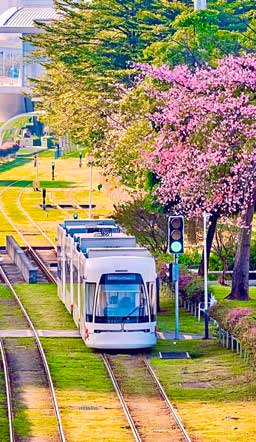
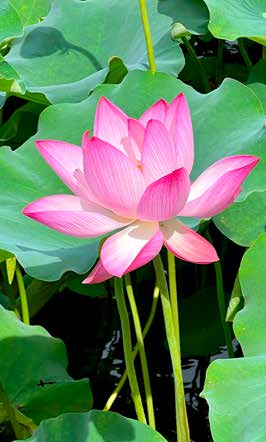
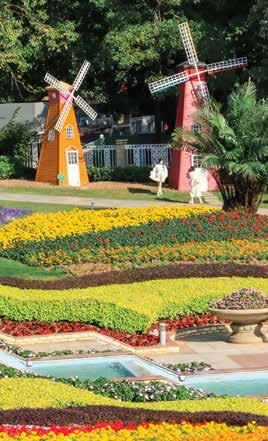
广州人自古就对鲜花情有独钟。明末清初,学者屈大均在《广东新语》中写“广州花贩,每日分载素馨至城,从此上舟,故名花渡头”——1 700年前五代南汉时期,珠江南岸庄头村广种素馨花,花农每天早上都会驾船满载素馨花入城卖花。早上现采的鲜花格外新鲜,花农挨家挨户送花上门,就和现在每日送新鲜牛奶上门一样常见。南宋人周去非在《岭外代答》中所写的“或以竹丝贯之,卖于市,一枝二文,人竞买戴”,描绘了花贩在集市上卖素馨花、人们争相购买的情景。到了明末清初,广州形成了初具规模的花市:花贩将花摆在城门口,方便人们购买,买花的人摩肩接踵,一派欣欣向荣的景象。广州花市传承至今,已经深入广州人的日常生活。每年腊月二十八至除夕夜,广州都会开放“八大花市”,有许多人会慕名前来。广州人爱逛的花市有越秀区西湖花市、天河区体育中心花市和海珠区沿江西路花市等。这时候的地铁里,人们身旁常有各色鲜花相伴,踏入车厢,仿佛置身于花海——这是独属于“花城”广州的浪漫与幸福。
People of Guangzhou have held a special affection for fresh flowers throughout history. In the late Ming and early Qing period, Qu Dajun, a famous scholar, wrote in his book New Writings of Guangdong how flower vendors loaded Sicilian jasmines onto their boats here (at the dock) and transported them across the city, giving rise to the name of this place, the 'Flower Dock'. He described for us how, around 1,700 years ago when the region was under the reign of the Southern Han, villagers of Zhuangtou on the southern bank of the Pearl River cultivated Sicilian jasmines extensively and loaded their boats with the blooms every day for sale. Farmers delivered the freshly cut lowers every morning door to door, similar to the common practice of delivering fresh milk to households today. Zhou Qufei, a scholar from the Southern Song period, vividly portrayed the bustling scene of people thronging to buy Sicilian jasmines in his local chronicle Lingwai Daida. He wrote, Vendors string Sicilian jasmine flowers with bamboo threads and sell them in the flower market. Each string is priced at two wen. People eagerly buy them and use the flowers for decoration. By the late Ming and early Qing period, Guangzhou witnessed the emergence of substantial flower markets. Flower vendors, stationed conveniently at the city entrance, attracted eager crowds, creating a vibrant, joyous atmosphere. Today, visiting the flower market has become a routine for the people of Guangzhou. Starting three days before Chinese New Year, the city's eight major flower markets open their doors to visitors. Among the favorites are the Xihu Flower Market in Yuexiu District, the Sports Center Flower Market in Tianhe District, and the West Yanjiang Road Flower Market in Haizhu District. If you happen to be at a subway station near these markets at this time of the year, you will be surrounded by a kaleidoscope of lowers, as if you were embraced by a sea of blooms. This is the romantic delight the city offers its people.
人潮汹涌的花市上,道路两旁摆放着各色各样的鲜花,到处都洋溢着满满的幸福感。人们带着家人或朋友,边聊天,边逛花市。无论是商场还是酒店,总会在大厅摆上一棵挂满红包的年橘。在粤语中,“橘”和“吉”读音相同,因此年橘有“吉祥如意”的美好寓意;金灿灿的橘子就像沉甸甸的珠宝,寄托着人们“招财进宝”的心愿。而在日常居家装饰中,人们喜欢在客厅插上一株挂满彩灯的桃花。桃花有“花开富贵”之意,在粤语中,“红桃”与“鸿图”谐音,象征着人们会在事业上大展鸿图,也承载着“行桃花运”的美好愿景。满树的点点红星,更是营造出一种“红红火火过大年”的气氛。
The busy lower markets with various lowers displayed on both sides of the roads exude a sense of festive joy. Family and friends stroll through the markets, chatting and laughing. During the Spring Festival period, local shopping malls and hotels put up in their lobbies a tangerine tree decorated with red envelopes. This is because in the Cantonese dialect, 橘 (tangerine) sounds the same as 吉 (auspiciousness). Therefore, the golden tangerine fruits, resembling jewelry in appearance, embody the businesspeople's good wishes for wealth and prosperity. Inside their homes, local people often place a peach blossom tree adorned with colorful lights in the living room. This is because peach blossoms are the symbol of wealth and reputation, and 红桃 (red peach) and 鸿图 (great ambition) have the same pronunciation in Cantonese. Thus, the peach blossoms represent Guangzhou people's aspirations for a thriving career and luck in romantic relationships. Besides, the vibrant color of red further elevates the joyous, exciting atmosphere during the festival.
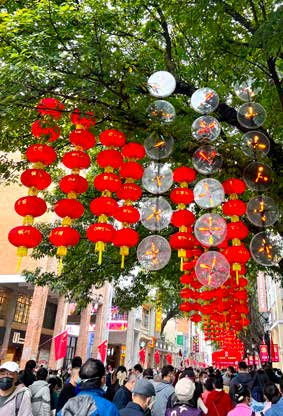
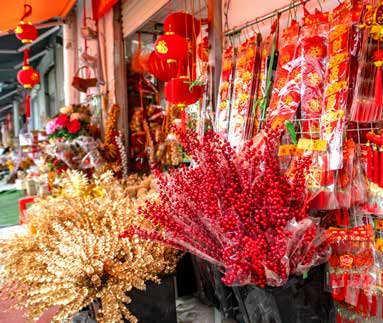
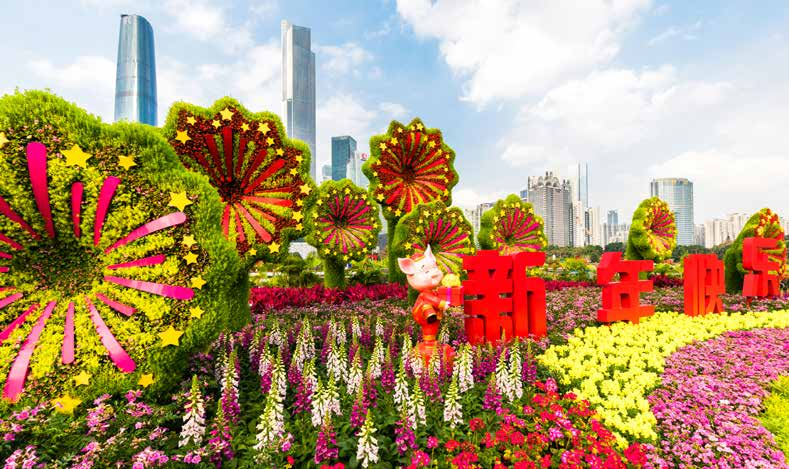
“没有鲜花的生活,就像没有餐具的盛宴。”鲜花是每一位广州人独特的记忆,寄托着人们对生活的热爱和对美好的期许,是烟火人间不可缺少的一缕馨香。在广州这座充满花香诗意的城市里,鲜花就是独特的城市“名片”,不仅见证着这座城市的发展与变迁,还带着美好的寓意,陪伴和祝福着一代又一代广州人。
Life without flowers is like a banquet without tableware. Flowers take a unique place among the locals, representing their passion for life and optimism for the future. Fresh flowers have become an iconic symbol of Guangzhou, adding a poetic and fragrant charm to the metropolitan. Flowers not only witness the city's transformation but also remain a cherished presence among the locals, embodying good wishes and blessings.



